Last weekend Fort Worth hosted a bigfoot convention. People from all over the United States 'including a number of self-proclaimed 'crypto-zoologists descended on Cowtown sporting 'We Are Not Alone ' T-shirts and oversized shoes that looked like hairy feet. Many of these convention goers came for the novelty of the event: they 'd watched shows like Finding Bigfoot and wanted to see why people were obsessed with a nonexistent creature. Most attendees, however, came because they believe that Bigfoot is real. That, somehow, a North American primate has evaded detection in a world with unmanned drones and Google Earth.
Although no one has managed to capture a sasquatch or even provided a bigfoot corpse, believers 'prove ' the existence of 'wood apes ' with fuzzy photographs, footprint molds, matted swatches of hair, and questionable DNA tests.
Bigfoot enthusiasts also reference historical accounts of hairy men. Cultures all over the world have legends of wild men that lived outside the comforts of civilization. American Indian folklore, in particular, is filled with tales of man-like beasts lurking in the woods. In Central America, the Tawahkas claimed that 'hairy men ' roamed the jungle and served as guards to the gateway to the afterlife. Perhaps the most famous of these American stories comes from the Pacific Northwest, where Indians believed that the hairy beasts lived on mountains and came down to steal fish from their nets. In some of these tales, bigfoots (bigfeet?) posses supernatural abilities, others are nothing more than humans with a wild streak, and still others are little more than another type of primate. While details vary, legends of hairy wild men abound.
One such wild man account comes from Texas. In fact, the first recorded bigfoot encounter in Texas happens to come from the first written anything from Texas. Yep, the first European to set foot in Texas came out with a bigfoot story.
The European 's name was Alvar N ez Cabeza de Vaca. Born in 1488 in Spain, Cabeza de Vaca came to the New World for the same reason many other Spaniards had: he wanted to find gold and glory. In 1521, Spanish conquistador Hern n Cort s defeated and subjugated the Aztecs, the most powerful Indian empire in the Americas. Cort s 's victory brought him wealth, power, and fame. It also made him the envy of every ambitious man in Spain. They wanted what Cort s had: to rule their own Indian kingdom full of gold and subjects. With this desire, thousands of would-be conquistadors descended on the Americas.
One such person was P nfilo de Narv ez. After Cort s 's conquest of the Aztecs, the Spanish Crown gave Narv ez title to colonize the area that is today 's northern Mexico and permission to subdue any Indian kingdoms he discovered. Narv ez would only have to pay a 20 percent tax on the gold and silver he found. To ensure that the conquistador paid this tax, the Crown assigned Cabeza de Vaca to be Narv ez 's treasurer and second in command. Six hundred men joined Narv ez and Cabeza de Vaca in Cuba and boarded ships for northern Mexico in early 1528.
In April 1528, a series of mishaps 'including the onset of a hurricane, poor navigating, and a misunderstanding of Caribbean ocean currents 'saw Narv ez and his expedition land not in northern Mexico, but instead near modern-day Tampa, Florida. Believing himself to be near his colonial claims, Narv ez disembarked with Cabeza de Vaca and 300 men and told his ships to sail north, where he planned to meet them shortly. Narv ez, Cabeza de Vaca, and the rest of the conquistadors then set off into the Florida interior to claim their riches.
Unfortunately for the Spaniards, Florida turned out to be, well, Florida. It was hot, miserably humid, and most of the Indians of the peninsula lived in poverty. There were no Indian kingdoms to be found, something that Narv ez and Cabeza de Vaca discovered only after months of trekking through alligator and mosquito-filled swamps. By August 1528, the conquistadors had not only failed to find an Indian kingdom, but had begun to die of starvation and exhaustion. Local Indians, upset when the conquistadors raided their villages for food, contributed to this body count by firing poison-laced arrows at the Spaniards. With his original compliment of 300 men dwindled to 250, Narv ez ordered his army to the coast to reunite with the supply ships. By this time, however, the ships had given up on the expedition and had returned to Spanish territory. Narv ez hoped to do the same, so he oversaw the construction of five crude rafts and set sail from northern Florida bound for Mexico.
The trip proved disastrous. The men had misjudged the distance to Mexico and had brought insufficient food and water. When a storm hit, Narv ez 's vessel was lost at sea. Cabeza de Vaca 's boat endured, but became separated from the rest of the boats and crashed off the coast of Texas, probably Galveston Island. There, the some forty surviving Spaniards began to die of starvation. Those that lived did so by consuming the flesh of their fallen comrades. This brought its own problems, as dysentery ravaged the survivors ' numbers. Soon, only Cabeza de Vaca remained of the men on his boat.
For the next five years, Cabeza de Vaca wandered Texas. He learned local Indian customs and languages and, for a time, he thrived as a trader amongst the various Indian groups. At one point while traveling in Central Texas, one of these tribes took Cabeza de Vaca as a prisoner and for a few years, he served as their slave. Eventually, Cabeza de Vaca discovered that a neighboring tribe had three survivors from one of the other Spanish boats. So Cabeza de Vaca made contact with these survivors 'one of whom was an African slave named Esteban 'and together they were able to escape their Indian captors. The four men then headed south, making their way to Mexico City in 1536, over seven years since first arriving in Florida. There, the men gave an account of their epic journey, with Cabeza de Vaca 's version of events being published as the book La Relaci n.
Cabeza de Vaca 's Relaci n contains some interesting information about the Spaniard 's time in Texas. He goes into depth about Indian diet, migratory habits, social structure, gender roles, and ways of war, valuable observations for historians because European diseases would decimate these tribes before more could be written about them. According to Cabeza de Vaca, some Texas Indians lived a comfortable, sedentary life in homes similar to those found in Spain. Other Indians constantly wandered, living off a diet of deer feces, lizards, and spiders. Although he never personally encountered a buffalo, Cabeza de Vaca saw buffalo hides and was the first to write about the animal. In one of his most poignant passages, Cabeza de Vaca noted that some Indian tribes had homosexual, transvestite males that performed women 's work and would act as women sexually.
Although these observations are fascinating, the most interesting story from Cabeza de Vaca 's Relaci n involves his time in a Coahuiltecan Indian village. Shortly after Cabeza de Vaca, the African Esteban, and the two other survivors escaped enslavement in Central Texas, they arrived in an Indian village in South Texas that had recently been attacked by a rival tribe. One Indian man had an arrowhead in his chest and was close to dying. Using rudimentary medical knowledge, Cabeza de Vaca removed the arrowhead, and the man soon recovered from his wound. Stunned, the tribe began to regard Cabeza de Vaca and his companions as gods, and they welcomed them to stay in their village. The Spaniards took them up on this offer and remained among the Coahuiltecan tribe for eight months. During this time they heard about bigfoot.
According to the Coahuiltecans, fifteen years before Cabeza de Vaca 's arrival (This would be sometime around 1519-1520) a hairy, man-like creature began to attack their village at night. The Indians described the being as a 'Bad Thing, ' which Cabeza de Vaca recorded in Spanish as 'Mala Cosa. '
In many ways, the Indians ' description of Mala Cosa fits our modern image of a sasquatch. Hair covered Mala Cosa 's face, setting him apart from the Coahuiltecans, whose Indian ancestry prevented them from growing beards. Also conforming to our perception of bigfoot, Mala Cosa was strong, strong enough to lift an Indian dwelling into the air and toss it to the ground. Much like sasquatch 'and Chewbacca, for that matter 'Mala Cosa could also rip a man 's arms from his sockets with ease.
Mala Cosa, however, was not the spitting image of bigfoot from those Jack Links commercials. For example, Mala Cosa was smaller than the average human, and he wore clothes. Sometimes the creature dressed in animal skins like an Indian male, other times he came covered like a female. Also unlike most reports of sasquatch, Mala Cosa was armed. He carried a sharp stone knife, which he used to carve three scars into his victim 's arms.
As described by the Coahuiltecans, Mala Cosa had supernatural powers. The Indians claimed that they always knew when Mala Cosa was coming into their village at night, because the hair on their arms and legs would stand on end. And just before the creature entered a home, a glowing vigil would appear on their doors. Mala Cosa would then enter the domicile, take a victim, and cut slashes into his or her arms with his sharp knife. The creature would sometimes slice open his victims ' abdomens, rip out their entrails, and toss them on to a fire.
According to the Indians, Mala Cosa wasn 't entirely evil. Using powers not understood by the Coahuiltecans, the creature would often seal his victim 's wounds after performing his sickening nighttime ritual. Mala Cosa would also come at nights when the Indians held dances, sneaking his way into their village unnoticed. At one point, the Coahuiltecans spoke to Mala Cosa and offered him food if he’d leave them alone. The creature refused the overture, but he did answer one of the Indian 's questions. When asked from where he came, Mala Cosa simply pointed to a crevice in the earth. After torturing the Indians for some time, Mala Cosa wandered off, and had not been seen for fifteen years prior to the Spaniards ' arrival.
Cabeza de Vaca reacted to the Coahuiltecan 's story like most of us react when watching Finding Bigfoot: he laughed his ass off and dismissed the story as nonsense. Nothing but a boogey-man tall tale. The Spaniard had seen some incredible stuff on his journey, but he refused to believe in a hairy magic man from the woods.
That was until the Coahuiltecans lined up one-by-one to relay their encounters with the Mala Cosa and to show Cabeza de Vaca where the creature had cut them with his knife. Scars covered the Indians ' bodies. This physical evidence, and the level of detail to the Coahuiltecans ' stories, convinced Cabeza de Vaca and his companions that Mala Cosa was more than a phantom. There was no way that these people would or could make up such an extensive lie. Devoutly Catholic, Cabeza de Vaca became convinced that the devil had sent Mala Cosa, and so the Spaniard set about instructing the Indians in the ways of Christianity. He informed them that a belief in the Christian God would ward off future visits from the satanic creature.
Except for references to Christianity, the encounter with Mala Cosa is the only supernatural aspect of Cabeza de Vaca 's Relaci n. Archeological and historical evidence can explain everything else in the book. Because of this, historians have been scratching their heads over what to make of the Mala Cosa story. Should it be dismissed as hokum? Does it discredit other aspects of Cabeza de Vaca 's story? Why would an otherwise factual narrative talk about a boogey man?
Donald Chipman, the preeminent scholar on Cabeza de Vaca, makes the argument that Mala Cosa was a sort of 'shared illusion. ' The creature represented the 'other, ' the things that 'go bump in the night. ' The Coahuiltecans, like most Indians, had shamans that attributed the unexplainable to the supernatural. Mala Cosa could have been a legend that was so engrained in Coahuiltecan society, that when they Indians had a bad year 'as they may have had fifteen years before Cabeza de Vaca 's arrival 'they personified their misfortune into the hairy creature.
In many ways, this explanation makes sense. Whatever the creature was, it didn 't have supernatural powers (sorry mystic bigfoot believers), so no matter what, some aspects of the Coahuiltecans ' story had to be made up. Why not all of it? It would wrap everything into a convenient package.
The only thing wrong with the supernatural explanation is that this is the only time that Cabeza de Vaca bought into the paranormal. He believed what the Indians were saying and he believed that the Indians believed what they were saying. A highly intelligent man, Cabeza de Vaca wouldn 't be fooled by hokum. He heard the Indian 's evidence, saw their scars, and concluded that something had attacked them fifteen years ago. Being a Christian, Cabeza de Vaca used the bible to explain Mala Cosa. Satan was responsible for the creature.
The Coahuiltecans believed Mala Cosa to be a magical, wild man-creature, Cabeza de Vaca argued that he was demonic, and historian Donald Chipman called Mala Cosa a 'shared illusion. ' There 's a third explanation: Mala Cosa was a European that had somehow reached Texas fifteen years before Cabeza de Vaca.
Robert Goodwin, author of Crossing the Continent, a biography of Esteban, believes Mala Cosa to be a Spanish slaver who came north from Mexico to capture Texas Indians. In some ways, Mala Cosa as a Spaniard makes sense. European ancestry would explain the creature 's hairy face, which would have set it apart from the beardless Indians. Mala Cosa 's sharp 'flint ' knife may not have been stone, but steel. Lacking a word for metal, and likely unable to comprehend the concept of metal without ever having seen it before, the Indians may have described the knife as being made of flint because it was the sharpest material they knew of.
There 's one thing wrong with Goodwin 's contention: when Cabaza de Vaca heard the Bigfoot story, Spanish expansion north from Mexico was still hundreds of miles south of Texas. If the Indians ' timeline was correct and Mala Cosa had arrived fifteen years before were true, then the Spanish would still be in the process of fighting the Aztecs. They wouldn 't expand northward with an enemy at their back. Even if some rogue band of Spaniards did make their way north, they probably wouldn 't be slavers, as their were plenty of potential slaves in population-dense Central America. There would be little reason to cross desolate northern Mexico for slaves.
Although this rules out Spanish slavers coming overland Mala Cosa, there is a possibility that Mala Cosa was a shipwrecked Spaniard. Spanish ships had been roaming the Caribbean since the arrival of Columbus in 1492, and many of these vessels had wrecked against uncharted shoals and coral reefs. Survivors then either died at sea or made their way to land. Before marching on the Aztecs in 1519, Cortes found a Spanish shipwreck survivor who had lived among the Indians of the Yucatan Peninsula for years. When one of the supply ships from the Narv ez expedition crashed off the coast of Florida, a man managed to make it to land. He survived among the Indians for over ten years before a Spanish expedition found him.
Could Mala Cosa be a shipwreck survivor or, maybe, a sailor who had been thrown overboard by a storm or his fellow crew? Again, Spanish origin would explain the hairy face and sharp, possibly metal, knife. It may also explain Mala Cosa 's strength. Sailors of the day were strong. They had to lug heavy lines across the deck of ships, climb rigging, and fight with difficult to manage rudders and helms. The Coahuiltecan village 's proximity to the sea 'probably some 50-100 miles 'would make it accessible to someone who had been shipwrecked. Finally, many of Mala Cosa 's actions could be explained as those taken by a desperate man in an unfamiliar environment. A shipwrecked sailor without food would raid an Indian village to obtain some. During these raids he 'd speak in a language unfamiliar to the village 's inhabitants, and, being scared and hungry, he would use violence to get what he wanted. Over the years, the Indians ' memory of this unfamiliar man could have exaggerated some of his qualities.
There 's also a historical president for Mala Cosa being a Spaniard who had come to Texas by sea. In 1519 'the exact time of Mala Cosa 's arrival reported by the Coahuiltecans 'Alonso lvarez de Pineda sailed four ships off the Texas coast. There were no shipwrecks, and there 's no evidence that any of the sailors on the vessels actually stepped foot off the ships while in Texas, but Pineda entered into many Texas bays. It 's possible that one of his men disembarked in Texas for one reason or another.
Even this theory has holes. Wouldn 't the Indians who had encountered Mala Cosa, recognize that he had a similar appearance to Cabeza de Vaca? Possibly, but by the time Cabeza de Vaca arrived in the Indian village, he had shed his European clothing and wore animal skins in Indian fashion, he spoke multiple Indian languages, he 'd grown deeply tanned from years in the Texas sun, and he 'd lost all of his metal and European items that would make him distinct from the Indians. Except for his beard, Cabeza de Vaca was more Indian than European when he met the Coahuiltecans. So much so that the first Europeans to encounter Cabeza de Vaca upon his return to Mexico thought that he was Indian. If Mala Cosa were a Spaniard who had just arrived in Texas, he would appear much different to Indians than Cabeza de Vaca and his companions.
Still, the shipwrecked Spaniard theory doesn 't answer everything. Where 'd the sailor go? Why wouldn 't he accept the food the Indian 's gave him? Why did he cut distinct marks into his victims ' arms? And could the Coahuiltecans ' memory of a man have distorted so much in fifteen years that they remembered him as having supernatural powers?
No explanation makes total sense. As such, the mystery of Mala Cosa will endure, and we 'll likely never know the true nature of who or what tortured the Indians of Texas in 1520. Lacking a plausible scenario, let 's just call Mala Cosa a bigfoot. It 's as good an explanation as any, and it will make our sasquatch-loving friends visiting Fort Worth very happy.
UPDATE: I spoke with Dr. Donald Chipman about the possibility that Mala Cosa was a sailor from one of Pineda’s ships or a shipwreck survivor. He acknowledged that this could explain the creature, but offered yet another possibility. In 1523, Spanish conquistador Francisco de Garay intended to land a 600-man army on the Panuco River in Central Mexico, but instead disembarked in what is today Tampico, Mexico, located just south of Texas. When Garay realized his error, he marched south, but not before a number of his men became lost and seperated from the main army. If one of these conquistadors made their way north to Texas, they could be Mala Cosa.
Brad Folsom





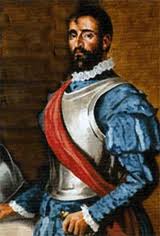
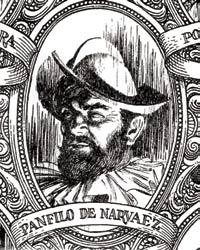

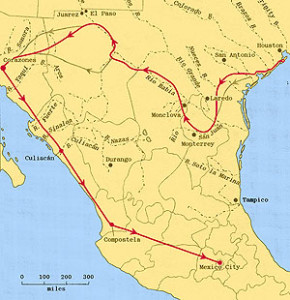

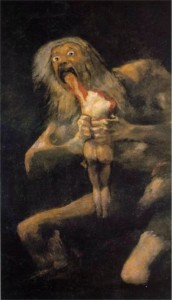
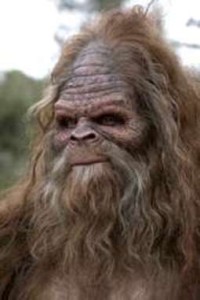




[…] In 1536, Alvar Nunez Cabeza de Vaca returned from an eight-year sojourn in North America. He 'd arrived in North America as part of a 600-man Spanish army, but after a shipwreck, conflict with Indians, starvation, and thousands of miles traveling across hostile jungles and deserts, only Cabeza de Vaca and three companions remained. The journey was epic, the four men becoming the first non-Indians to step foot in what would one day become Texas and Northern Mexico. When they returned to Mexico City and the company of other Europeans, Cabeza de Vaca relayed details about the people, animals, and environment he 'd encountered. His stories were incredible, but one tale stuck out more than any other: Cabeza de Vaca had found evidence of a magical, hairy creature that would attack people. (We 've written about this before. Click here to read the story in greater detail.) […]